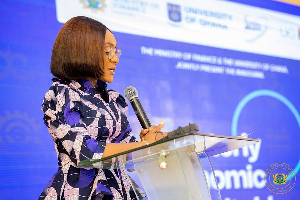- Home - News
- TWI News | TV
- Polls
- Year In Review
- News Archive
- Crime & Punishment
- Politics
- Regional
- Editorial
- Health
- Ghanaians Abroad
- Tabloid
- Africa
- Religion
- Election 2020
- Coronavirus
- News Videos | TV
- Photo Archives
- News Headlines
- Press Release
- News Blogs
Business News of Tuesday, 2 July 2024
Source: thebftonline.com
B&FT Editorial: Remittance flows can be a reliable source of foreign exchange
Ghana receives the second highest remittance inflows in Africa, the latest World Bank Migration and Development Brief has shown.
Indeed, sub-Saharan Africa saw remittance flows reached US$54billion in 2023 while remittances to the country reached US$4.6billion, surpassed only by neighbouring Nigeria’s US$19.5billion.
The figure is marginally lower than the US$4.7billion recorded in 2022. In 2021, the value of remittances into the country stood at US$4.5billion. These funds play a crucial role in stabilising the nation’s financial health.
These inflows have been instrumental in mitigating the effects of food insecurity, drought, supply chain disruptions, floods and debt-servicing difficulties. Such economic challenges have been exacerbated by global geopolitical tensions, including the Russian invasion of Ukraine and the Israel-Gaza conflict.
While foreign direct investment (FDI) flows have been dodgy, remittances have proven to be a more reliable source of foreign exchange for sub-Saharan Africa. In 2023 remittances to the region were nearly 1.5 times the size of FDI flows, which stood at US$38.6billion. The largest recipients included Nigeria, Ghana, Kenya and Zimbabwe.
Ghana’s dependence on remittances has become increasingly evident. These inflows not only support the current account but also provide a buffer against various economic shocks. For many Ghanaians, remittances from family members abroad represent a critical source of income.
In fact, the report highlights the stabilising effect of these funds. However, the high cost of remittances remains a concern. Senders paid an average of 7.9 percent to send US$200 in 2023Q4, up from 7.4 percent in 2022Q4.
Costs vary significantly, with some corridors charging as much as 36 percent. This underscores a need for more affordable and efficient remittance channels.
Looking ahead, remittance growth to sub-Saharan Africa is projected to recover slightly, from a negative growth of -0.3 percent in 2023 to an anticipated 1.5 percent increase in 2024. However, several risks loom on the horizon – including potential economic slowdowns in developed countries, escalating conflicts and climate risks.











